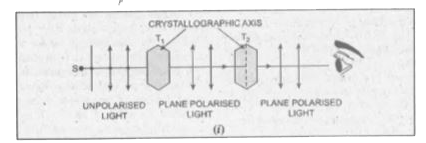How can you detect a polarized light?
Take two tourmaline crystals T1 and T2 cut with their faces parallel to the axis of the crystal. A fine beam of light from the source S is passed through T1 and light is observed by placing eye behind T2.

When the axis of T1 and T2 are parallel, maximum light is observed [Fig. (i)] but when the axis of T1 and T2 are crossed (perpendicular), then practically no light is observed. This phenomenon can only be explained if light waves are transverse. Light falling on T1 has transverse vibrations lying in all possible directions. T1 allows only vibrations which are parallel to the axis of T1 . If second crystal T2 is placed parallel to T1 as in first figure, then vibrations transmitted by T1 are also transmitted by T2. If T2 is perpendicular to T1, the vibrations from T1 are perpendicular to the axis of T2. Hence T2 will not allow these vibrations to pass [Fig. (ii)].
Longitudinal vibrations can however pass through slits irrespective of their orientations. This is the reason as to why the sound waves cannot be polarised.
Due to the change of the intensity of polarised light as a result of relative orientation of their crystallographic axis, it is concluded that the light waves must be transverse in nature.
Topper's Solved these Questions
- OPTICSBOOK - MBD -HARYANA BOARDCHAPTER - OPTICSEXERCISE - LONG ANSWER TYPE QUESTIONS
18 Videos
- OPTICSBOOK - MBD -HARYANA BOARDCHAPTER - OPTICSEXERCISE - OBJECTIVE TYPE QUESTIONS
26 Videos
- OPTICSBOOK - MBD -HARYANA BOARDCHAPTER - OPTICSEXERCISE - OBJECTIVE TYPE QUESTIONS
26 Videos
- MODEL TEST PAPER - 2BOOK - MBD -HARYANA BOARDCHAPTER - MODEL TEST PAPER - 2EXERCISE - SET - D ( LONG ANSWER TYPE QUESTIONS)
4 Videos
- PRINCIPLES OF COMMUNICATIONBOOK - MBD -HARYANA BOARDCHAPTER - PRINCIPLES OF COMMUNICATIONEXERCISE - Objective Type Questions
19 Videos
Similar Questions
Knowledge Check
The property by virtue of which a compound can rotate plane polarized light is known as
APhottolysisBPhosphoresceneCOptical activityDPolrizationOrdinary light is converted into plane polarized light by passing through a ________.
Anickel prismBglass prismCNicol prismDglass slab
What is meant by plane polarized light ? What type of waves show this property ? Describe a method for producing a beam of plane polarized light.
View SolutionCan a naked eye detect polarization of light ? If not, how is polarization of light detected ?
View SolutionHow can you obtain lampblack?
View Solution(a) Distinguish between unpolarized light and linearly polarized light. How does one get linearly polarised light with the help of a plaroid ?
(b) A narrow beam of unpolarised light of intensity I0 is incident on a polaroid P1. The light transmitted by it is then incident on a second polaroid P2 with its pass axis making angle of 60∘ relative to the pass axis of P1. Find the intensity of the light transmitted by P2.
View SolutionThe degree of polarization of partially polarized light is P=0.25. Find the ratio of intensities of the polarized component of this light and the natural component.
View SolutionName the scientist who discovered that sunlight consists of seven colours.
View Solution
